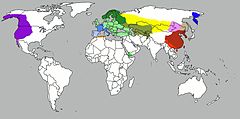The title says “things” but conferences are mainly about people.
Some of it can be serendipitous. For example, one day I sat next to Jonathan Rougier at lunch because I had a question for him about climate models. When Jonathan left, I started a conversation with the person on my other side. That was most certainly intellectually stimulating, and possibly of professional significance. I don’t think it was an encounter that either of us could have predicted.
John Fox
The some function in the car package selects a random sample (in order) from an object:
> some(data.frame(letters,rnorm(26)))
2 b -2.8214733
5 e -0.5271386
8 h 0.1833885
9 i 0.4101778
11 k 0.8804141
14 n -1.7534491
18 r -0.7533554
19 s 0.3520450
20 t -0.4211988
21 u 0.3910380
This definitely passes the jealousy test: Why didn’t I think of that?
Bettina Grün and Achim Zeileis
Beta regression (implemented in package betareg) is an alternative to logistic regression. It can do better because it more accurately estimates the heteroscedasticity. Recursive partitioning is an option in the package.
Richie Cotton
gWidgets and ggplot2 are a great combination for creating simple menus of plots.
Note:
- The word “easy” was in the title of his talk
- That turned out not to be an ironic use of the term
Simon Urbanek
The iplots package implements a lot of very nice interactive plotting for high-dimensional data.
Barry Rowlingson
It is possible to get an RSS feed for R tagged questions on Stackoverflow. And by extension to the Quantitative Finance section of Stack Exchange.
Jonathan Rougier
Nomograms are cool.
The slides for the talk and related material are available on Jonathan’s homepage most of the way down in the Miscellaneous section.
Adrian Waddell
The RnavGraph package allows a way to move through high-dimensional data with dynamic graphics in a way that is comprehensible to us mortals who are limited to visualizing at most three dimensions.
Andrej Blejec
Andrej taught me (among other things) that people can feel out of place in using the development version of R — thinking that you must be a “Developer” with a capital D. Using the development version can be a very valuable thing to do. This is especially true if you live in a locale that is not very well tested otherwise.
Andrew Runnalls
The CXXR project is attempting to translate the guts of R from C to C++.
Tal Galili
Items on R bloggers are not peer-reviewed … but they are Tal-reviewed.
Peter Dalgaard
Peter taught me that I’m “that infernal guy”.
Frank Harrell and Rich Heiberger
I learned about the range of magpies — genus pica of the Corvidae. (I’ve long known that corvidae are cool.)
Figure 1: Magpie in Glasgow Scotland (picture by Eggybird via everystockphoto.com).
If they are in the western US and in Britain (the two places I’ve lived), why would they not be in the eastern US?
I’ve lived with two different species: pica pica in Europe and pica hudsonia in America. The theory seems to be that they don’t like the heat and humidity of the summers in the eastern US.
Figure 2: Pica ranges (via Wikipedia): 
Related posts
Other things I learned at useR!2011:
- A view of useR!2011 (with some interesting comments, including one by Martin Mächler)
- Random input software testing
